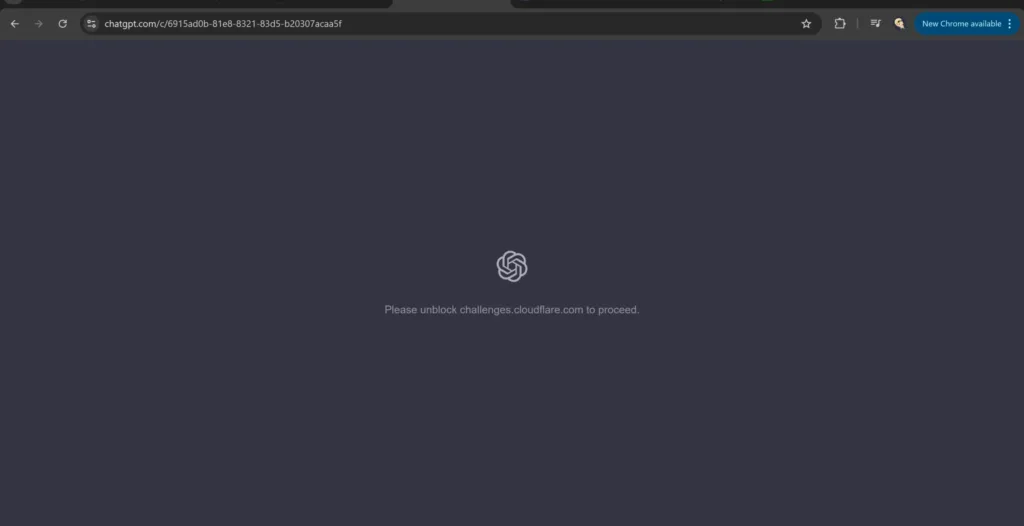Table of Contents
We see major internet disruptions on a regular basis, but the massive Cloudflare outage that struck users across the globe today stands out because of its scale, speed, and sudden impact. Cloudflare serves as a core internet infrastructure provider for thousands of platforms, so a failure inside its network can instantly lock out millions of people. That is exactly what happened during this outage, as users reported broken websites, failed logins, blank timelines, and entire applications that stopped responding without warning.
Cloudflare confirmed that its teams were investigating an anomaly that disrupted the performance of websites and services connected to the network. The company warned that people might face errors on multiple applications. This event hit social media, AI platforms, gaming servers, media outlets, and even the services that usually monitor outages. The widespread failure highlighted how dependent the digital ecosystem is on Cloudflare’s infrastructure, and it gave internet users an unexpected reminder of how quickly a single point of failure can ripple across the entire online environment.
Cloudflare Outage Hits X, ChatGPT, Gaming Services, and Media Platforms
Cloudflare disruptions began showing up early in the day as users on X, the platform formerly known as Twitter, noticed that posts refused to load. Entire timelines appeared blank. Refreshing did not help. Images and videos stopped appearing. Many desktop users saw full access failures, while mobile users experienced partial loading. This made X one of the most visible victims because users rely on it to discuss outages in real time.
However, the problem did not stay isolated. It spread across several major platforms as the network issues intensified. Letterboxd users could not access movie lists. Downdetector, the platform that tracks outages, experienced outages of its own. This was especially striking because Downdetector plays a key role during incidents like this. Its failure made troubleshooting harder for users who depend on its alerts.
Multiple Cloudflare internal systems also went down, limiting visibility into the company’s own troubleshooting tools. This added tension, since internal disruptions can make the recovery process slower.
ChatGPT users soon felt the outage as well. People trying to access the AI service reported blocked pages, slow responses, or full error screens. Since Cloudflare supports the infrastructure that handles requests and routing, any disruption can interrupt communication between the user and the AI model. As more reports surfaced, it became clear that AI platforms were heavily hit.
Even online gaming services were affected. League of Legends players faced severe connection failures. Many could not enter the game at all. Others lost access mid-session. Large multiplayer games depend heavily on stable routing, so Cloudflare’s lapse produced visible and immediate consequences for the gaming community. Chat groups filled with complaints as global servers struggled to stay online.
Media outlets also suffered. Platforms like ResetEra, Forocoches, and Menéame displayed internal server errors. In all cases, the error messages directly referenced Cloudflare, confirming that the infrastructure layer was the root cause.
This chain reaction showed how large Cloudflare’s footprint really is. Any widespread failure inside this system can instantly travel through the online environment and interrupt platforms that have no direct connection with one another, aside from relying on the same network backbone.
Why the Cloudflare Outage Happened and How It Spread Globally
As Cloudflare continued investigating the disruption, early reports suggested that the incident might be connected to scheduled maintenance. Several technical outlets stated that Cloudflare had planned maintenance work in multiple regions, and that some servers may not have responded correctly. This created a situation where network paths failed or returned error responses, which then cascaded through websites that depended on Cloudflare’s routing.
Cloudflare did not release full technical details immediately, but all signs pointed to a significant anomaly inside its infrastructure layer. Scheduled maintenance is common, but when parts of the network fail to respond as expected, the balance between servers breaks. This can cause routing loops, packet losses, or unresponsive verification services. When this happens at a large scale, applications experience timeouts, connection failures, or access blocks.
The uncertainty grew because outage-tracking websites also failed. Downdetector, which normally verifies service disruptions, became unreliable due to its own reliance on Cloudflare. Down for Everyone or Just Me also faced issues. This created a rare moment where millions of users faced errors but had no dependable way to confirm the root cause.
While users tried to reload their pages, many were redirected to Cloudflare challenge screens. These challenge pages normally appear during bot detection or security verification. In this case, they showed up because the network could not complete its routines.
This is where your screenshots become important, because they show exactly how the failure appeared to normal users.
Cloudflare Outage Screenshots and What They Mean
Users across different services captured screenshots displaying Cloudflare challenge messages. These messages highlighted how deeply the failure affected access verification.

The first screenshot shows a Perplexity.ai page stuck behind a Cloudflare security challenge. The page displays a request asking the user to unblock “challenges.cloudflare.com”. This indicates that Cloudflare’s verification system failed to complete its process. The challenge screen usually verifies browsers through checks, but the outage disrupted this action. As a result, users could not pass the verification and were locked out of the service entirely

Read More About Our Article of ChatGPT Outage Hits UK Users as OpenAI Scrambles to Restore AI Service Published on October 25th, 2025 SquaredTech
The second screenshot shows ChatGPT presenting the same type of challenge block. The page includes a verification message stating that the user must unblock the Cloudflare challenge website to move forward. This confirms that the AI platform could not communicate with Cloudflare’s verification servers. The block appears even before the application loads, which means the request died at the infrastructure stage before reaching any AI model.
These screenshots provide valuable evidence of how the outage affected different services. Although the platforms themselves did not fail on their own, the surrounding infrastructure malfunctioned, cutting off user access before the platforms had a chance to respond.
Wider Impact and What Users Should Expect Next
As Cloudflare worked on restoring services, users had little choice but to wait. Outages caused by infrastructure-level failures cannot be solved from the user side. Restarting devices or clearing caches does not help, because the issue does not originate from local systems. The outage lives inside the network routes and the verification checkpoints that Cloudflare controls.
Services dependent on Cloudflare may take time to fully recover, even after the core issue is resolved. Some websites refresh quickly, while others require complete resets of their routing rules. Gaming servers may need to reestablish stable sessions. AI platforms might face delays as queued requests attempt to reconnect.
In events like this, recovery always comes from the infrastructure provider. Users can monitor official Cloudflare channels for updates, but patience becomes the only reliable action until normal service returns.
This outage shows how significant Cloudflare’s role is across the modern internet. Its presence in social media platforms, AI services, media outlets, and gaming networks reveals how interconnected digital platforms have become. While this connection creates convenience during stable times, it also creates vulnerability when a major node experiences trouble.
As users around the world wait for systems to stabilize, the event will likely spark conversations about redundancy, load management, and global routing reliance. Large-scale outages often influence the strategies companies use to distribute their networks, and this incident may encourage platforms to rethink how many critical systems depend on a single provider.
At SquaredTech, we track key disruptions like this closely because they highlight important infrastructure pressure points for developers and users. Understanding the cause and impact helps the public recognize how internet architecture influences everyday services.
Cloudflare continues to work on the anomaly, and full restoration will follow their internal diagnosis. Until then, users must monitor updates, refresh occasionally, and expect temporary disruptions as systems come back online.
Stay Updated: Tech News


